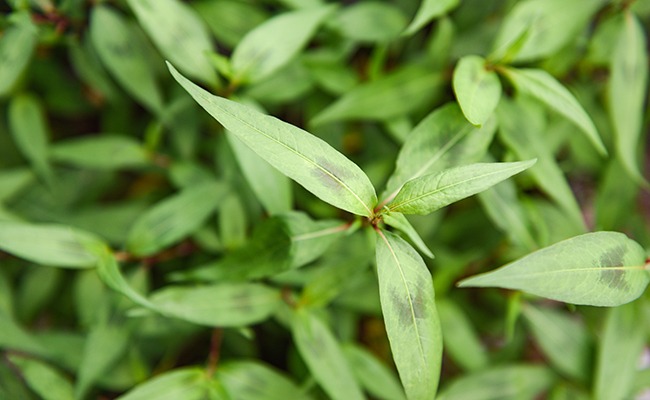Vietnamese coriander (Persicaria odorata syn. Polygonum odoratum) Where Rau ram in Vietnam, also called Vietnamese mint or Chinese basil, is an aromatic tropical perennial plant native to Southeast Asia which, in European latitudes, does not overwinter since it freezes from 7 to 10°C. But in countries with a hot climate, it can be invasive, especially since its growth is rapid.
Vietnamese coriander develops red stems that give it a creeping habit on which grow alternate, lanceolate, dark green leaves marked with a reddish-brown V. It is reminiscent of lady’s thumb (Polygonum persicaria) very vigorous. When crushed, the leaves of Vietnamese coriander give off a more spicy coriander smell and a peppery flavor combined with that of lime.
In summer, spikes of small pinkish-white flowers rise but flowering is often confined to plants living in their natural environment.
Its cultivation in pots allows it to be brought in sheltered from the frost in winter to make Vietnamese coriander last from one year to the next, and to harvest its leaves to cook emblematic dishes of Southeast Asian cuisine. .
- Family: Polygonaceae
- Type: evergreen perennial
- Origin: Vietnam and Southeast Asia
- Color: dark green and reddish brown leaves
- Sowing: yes
- Cutting: yes
- Planting: spring
- Flowering: summer
- Height: 0.30 to 0.50 m (0.50 m spread)
Ideal soil and exposure for Vietnamese coriander
Vietnamese coriander is grown in a warm, light and sheltered situation, or in partial shade in the garden, without direct sunlight, in rich, moist and well-drained soil.
Date of sowing, cutting and planting Vietnamese coriander
Sowing is done in a warm place, around mid-March, at 18-20°C. Transplanting in buckets will follow before setting up in the garden or in a pot.
Stem cuttings succeed easily when taken in late spring or late summer, then placed in a glass of water or a bucket of moist soil.
Division in fall or spring can also be considered when repotting in a larger container.
Planting is planned for spring, from mid-May, when frosts are no longer to be feared.
Council of maintenance and culture of the Vietnamese coriander
The Vietnamese coriander grown in pots should be placed outside from mid-May until autumn, then brought back into the greenhouse before the first frosts. A pot placed on a bed of gravel or in a cache-pot will increase the humidity. It is easy to grow.
Regular watering during the growth period should be reduced in winter.
If it loses its leaves with temperatures that are a little too cool, Vietnamese coriander can quite well start from the stump if the cold has not damaged it.

Harvesting, storing and using Vietnamese coriander
The leaves are harvested throughout the growth period, which allows the stems to be pinched to promote the appearance of new shoots.
They are eaten fresh, can be frozen but drying them loses some of their flavor.
In the kitchen, in Southeast Asian dishes, such as pho Vietnamese, curries, stir-fries, nems, spring rolls, fresh leaves are added at the end of cooking. Be careful, their spicy character is strong and concentrated!
Diseases, pests and parasites of Vietnamese coriander
Vietnamese coriander is not susceptible to disease or attacks from any pests or pests.
Location and favorable association of Vietnamese coriander
It is a plant that is grown in a pot indoors, in suspension, on a windowsill, or outdoors as an annual aromatic plant.
Recommended species and varieties of Persicaria for planting in the garden
Genre Persicaria counts around 80 species but they are sometimes confused with the genus polygonum.
In addition to Vietnamese coriander (Persicaria odorata) as an aromatic, you may plant in the ornamental garden, the amplexical lady’s-eye (Persicaria amplexicaulis) non-invasive, with pretty flowers ranging from pink to purple, the knotweed (Persicaria scoparium) which looks like a horsetail, the dyer’s knotweed (Persicaria tinctoria) which colors indigo…
You won’t, of course, plant Japanese knotweed (Fallopia japonica) invasive from the same family…
About the coriander (Coriandrum sativum)it only has the vernacular name in common since they do not belong to the same family or to the same genus.
We want to thank the author of this article for this remarkable material
Vietnamese coriander (Persicaria odorata), emblematic of Vietnamese cuisine
You can find our social media profiles as well as other pages that are related to them.https://nimblespirit.com/related-pages/

